Mississippi’s landscapes, from lush woodlands to vibrant gardens, come alive with the hum of tiny jewels on wings. Hummingbirds dart from flower to flower, their iridescent feathers catching the sunlight in flashes of green, red, and gold. Observing these energetic birds up close is a magical experience that delights both novice and seasoned birdwatchers alike.
Each hummingbird species in Mississippi has its own personality, flight style, and favorite feeding spots. From the familiar Ruby-throated Hummingbird to rare visitors like the Mexican Violetear, spotting and identifying them offers a rewarding challenge. Gardens, woodland edges, and even urban yards can become stages for these acrobatic flyers.
Whether sipping nectar from a trumpet vine or chasing rivals midair, hummingbirds showcase incredible agility and charm. Knowing where to look and when to watch can turn an ordinary afternoon into a thrilling wildlife encounter. This guide will help you identify all 11 hummingbird species recorded in Mississippi, complete with pictures and key identification tips.
Types of Hummingbirds Found in Mississippi
Ruby-throated Hummingbird (Archilochus colubris)

The Ruby-throated Hummingbird is the most common hummingbird species in Mississippi, easily recognized by its brilliant red throat in males and a more subdued white throat in females. These tiny birds exhibit emerald green upperparts and grayish-white underparts, making them dazzling yet subtle when perched among flowers. Their slender, straight bills are perfectly adapted for sipping nectar from tubular blooms.
Adult males typically measure around 3 to 3.5 inches in length with a wingspan of about 3.1 to 4.3 inches, while females are slightly larger. Their rapid wingbeats allow them to hover in place and even fly backward, a distinctive hummingbird trait. During flight, the metallic green sheen of their back is particularly noticeable in sunlight, making them identifiable even from a short distance.
Ruby-throated Hummingbirds primarily feed on nectar from native flowers, feeders, and small insects or spiders for protein. They are highly territorial, especially males, aggressively defending their feeding areas from intruders. Their courtship displays involve dramatic dive flights and audible wing trills to attract females during breeding season, which occurs from late spring through summer in Mississippi.
In Mississippi, they inhabit gardens, woodlands, and open areas with abundant flowering plants. They migrate annually, wintering in Central America and returning north in spring. During migration, they can cover nonstop distances over the Gulf of Mexico, making them remarkable long-distance travelers despite their small size.
Rufous Hummingbird (Selasphorus rufus)
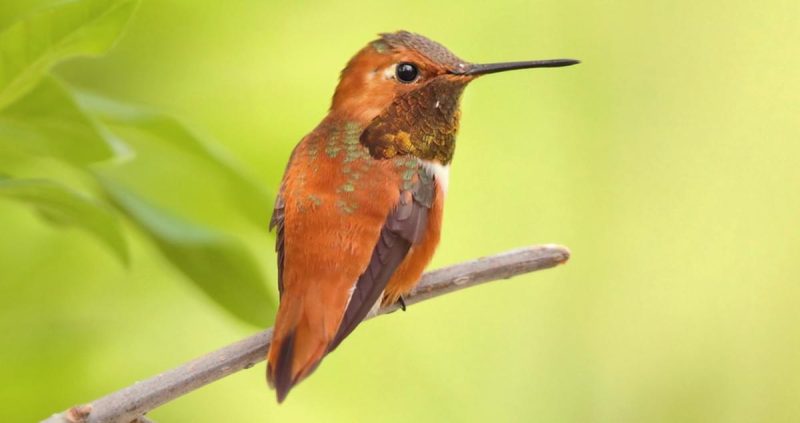
The Rufous Hummingbird is known for its striking rufous-colored back and sides, with males displaying a vibrant reddish-orange throat called a gorget. Females and immature birds are duller with greenish backs and speckled throats, yet still maintain the warm reddish tones on their flanks. Their slightly shorter, straight bills are adapted for a wide variety of flowers.
These hummingbirds are small, measuring 3 to 3.5 inches in length with a wingspan of 4 inches. Their rapid wingbeats produce the characteristic humming sound, which can be heard as they dart between flowers. They are incredibly agile flyers, capable of hovering for long periods while feeding or chasing intruders from their territory.
Rufous Hummingbirds feed primarily on nectar, supplementing their diet with small insects and spiders. Males are fiercely territorial and can dominate feeding areas, often chasing larger hummingbirds away. Their aggressive nature is most noticeable during breeding and migration periods, where they defend food sources and roosting sites.
In Mississippi, Rufous Hummingbirds are considered rare visitors, mostly seen during spring and fall migration. They prefer open woodlands, gardens, and forest edges where flowering plants are abundant. Their extensive migration takes them from Alaska and western Canada to wintering grounds in Mexico, making their occasional appearances in Mississippi exciting for birdwatchers.
Black-chinned Hummingbird (Archilochus alexandri)
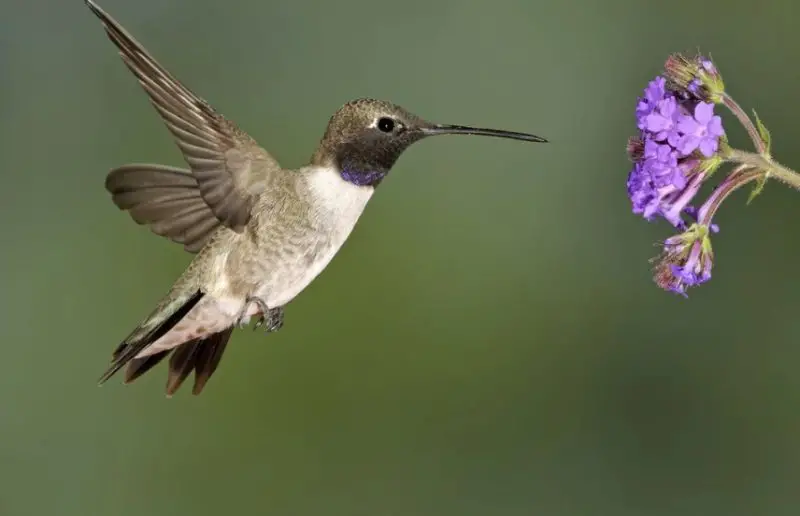
The Black-chinned Hummingbird is identified by its iridescent purple-black throat in males and grayish-white throat in females. Its back is green with grayish-white underparts, and males have a small black face mask extending from the throat. The slender, slightly curved bill allows it to access nectar efficiently.
Adults measure about 3 to 3.5 inches long with a wingspan around 4 inches. The Black-chinned Hummingbird is highly maneuverable, with rapid wingbeats that allow it to hover and dart quickly between flowers. Their small size and subtle coloration make them harder to spot compared to more brightly colored hummingbirds.
Their diet consists mainly of nectar from tubular flowers and sugar water from feeders, supplemented with insects and spiders for protein. They exhibit territorial behavior, defending feeding areas aggressively against other hummingbirds. Courtship involves aerial displays where males hover and make rapid upward and downward dives to impress females.
In Mississippi, Black-chinned Hummingbirds are rare visitors, typically passing through during migration. They favor open woodlands, gardens, and scrubby areas with plentiful nectar sources. Their natural range spans the western United States, but they occasionally stray east, making sightings in Mississippi notable for enthusiasts.
Buff-bellied Hummingbird (Amazilia yucatanensis)

The Buff-bellied Hummingbird is distinctive for its olive-green upperparts and warm buff-colored belly, with males featuring a bright red bill tipped with black. The throat is a subtle metallic green, blending smoothly with the back. Females are slightly duller with muted belly tones. This hummingbird’s compact size and striking coloration make it easily recognizable when present.
They are small birds, measuring roughly 3.5 inches in length with a wingspan of about 4 inches. Their flight is quick and precise, allowing them to hover in place while feeding or chasing other hummingbirds from feeders. The rapid wingbeats produce a faint hum, a hallmark of their species.
Buff-bellied Hummingbirds feed primarily on nectar from flowering plants and feeders, but they also catch small insects and spiders for additional nutrients. They are generally less aggressive than Rufous or Ruby-throated Hummingbirds but will defend rich food sources when necessary. Mating displays are subtle and involve hovering in front of females with slight wing vibrations.
In Mississippi, Buff-bellied Hummingbirds are occasional visitors, mostly spotted in the southern regions near the Gulf Coast. They prefer gardens, open woodlands, and shrublands rich in flowering plants. Their primary range includes Texas, Louisiana, and parts of Mexico, making Mississippi sightings special for birdwatchers.
Broad-tailed Hummingbird (Selasphorus platycercus)
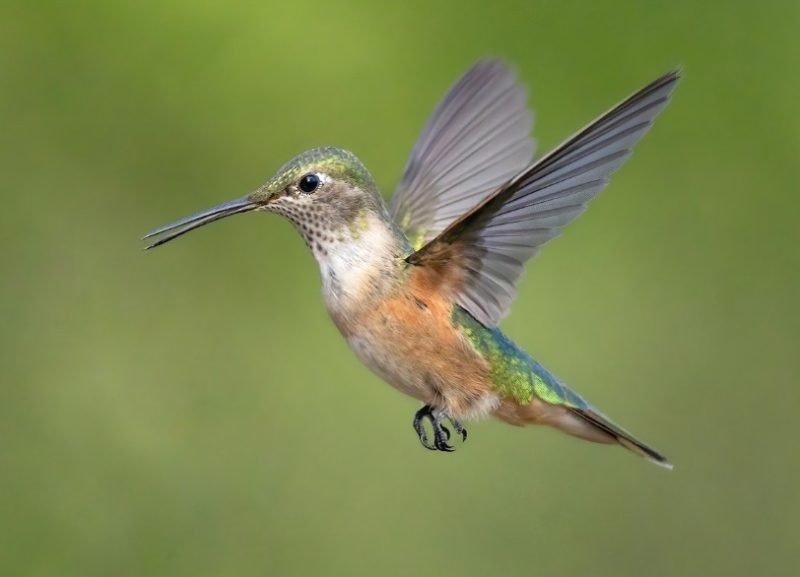
The Broad-tailed Hummingbird features a metallic green back with males displaying a bright rose-red throat patch. Females are grayish-white below with green backs and lack the vibrant throat coloring. They have a short, straight bill well-suited for accessing a variety of nectar sources. Their rounded tail feathers help distinguish them from other similar hummingbirds.
Adults measure about 3.25 to 3.5 inches in length with a wingspan of around 4 inches. Their flight is steady and agile, capable of rapid hovering, forward flight, and swift maneuvers. During flight, males create a characteristic whirring sound with their tail feathers, especially during display dives.
Broad-tailed Hummingbirds feed on nectar from flowers and feeders, complementing their diet with small insects and spiders. They are moderately territorial, often defending their feeding areas but less aggressively than Rufous Hummingbirds. Their courtship displays are dramatic, involving high-speed dives and wing trills to attract females.
In Mississippi, Broad-tailed Hummingbirds are rare vagrants, most often seen during spring migration. They inhabit open woodlands, mountain meadows, and gardens when present. Their typical breeding range is in the western U.S., but their occasional eastern appearances delight birdwatchers looking for uncommon hummingbird species.
Calliope Hummingbird (Selasphorus calliope)
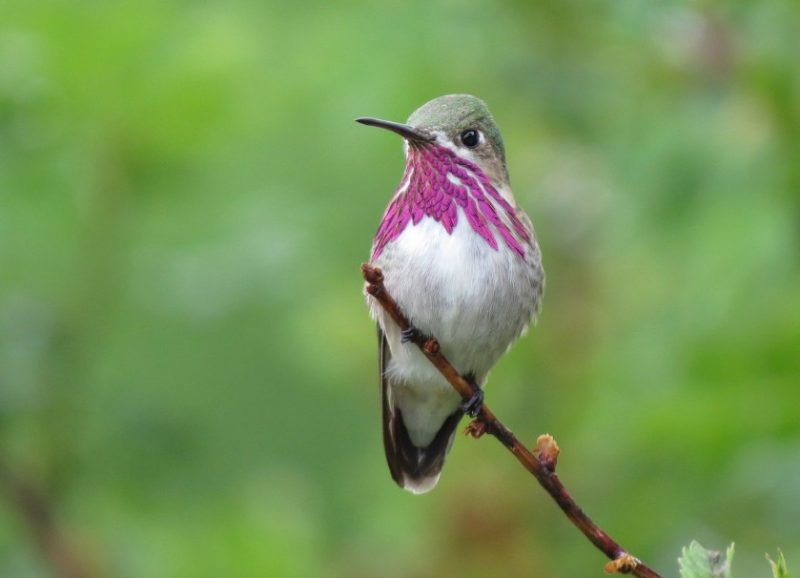
The Calliope Hummingbird is North America’s smallest hummingbird, measuring just 3 inches in length. Males are distinguished by their striking magenta throat streaks that extend downwards in thin lines, contrasting with their green back and grayish-white underparts. Females lack the magenta gorget but have subtle streaks on the throat and a plain green back, making them more understated.
Despite their tiny size, these hummingbirds are agile fliers with rapid wingbeats that allow precise hovering and backward flight. Their small, straight bills are well-adapted for extracting nectar from tiny flowers, and their delicate build allows them to navigate dense shrubs with ease.
Calliope Hummingbirds feed primarily on nectar but also consume small insects and spiders for protein. Males are territorial during the breeding season, performing aerial displays to defend feeding territories and attract females. Courtship dives produce audible wing trills, adding to their charm.
In Mississippi, Calliope Hummingbirds are rare vagrants, usually passing through during spring migration. They favor open woodlands, gardens, and shrubby areas when present. Their primary breeding range is the northwestern U.S. and southwestern Canada, while they migrate to Mexico for winter.
Allen’s Hummingbird (Selasphorus sasin)
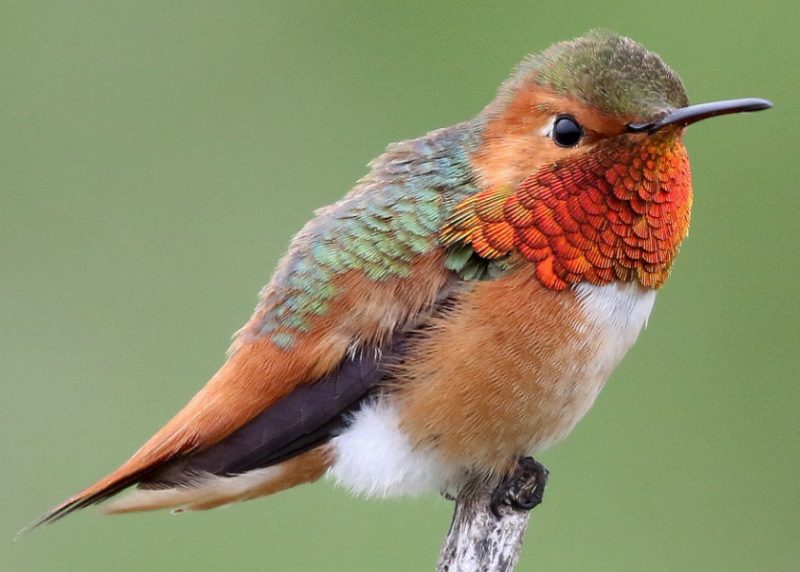
Allen’s Hummingbird is slightly larger than other Selasphorus species, measuring 3.25 inches long. Males feature a bright orange-red throat with green backs and flanks that fade into rusty sides. Females are green above with light underparts and subtle orange flanks, lacking the bright throat patch. Their slender bills allow them to feed efficiently on a variety of nectar sources.
These birds are skilled fliers, capable of hovering in place while feeding or maneuvering through dense vegetation. Their wings beat rapidly, producing a high-pitched hum, and they can perform rapid directional changes during territorial chases or courtship displays.
Allen’s Hummingbirds feed on nectar, using their long tongues to extract it from tubular flowers, and supplement with small insects for protein. Males are territorial, often chasing away rivals from feeders and flower patches. Breeding behavior includes hovering display flights and short dive-bomb maneuvers to attract females.
In Mississippi, Allen’s Hummingbirds are rare visitors, mainly seen during migration. They prefer gardens, woodland edges, and areas with abundant flowering plants. Their normal breeding range is along the Pacific Coast, and they spend winters in Mexico, making sightings in the southeastern U.S. noteworthy.
Anna’s Hummingbird (Calypte anna)
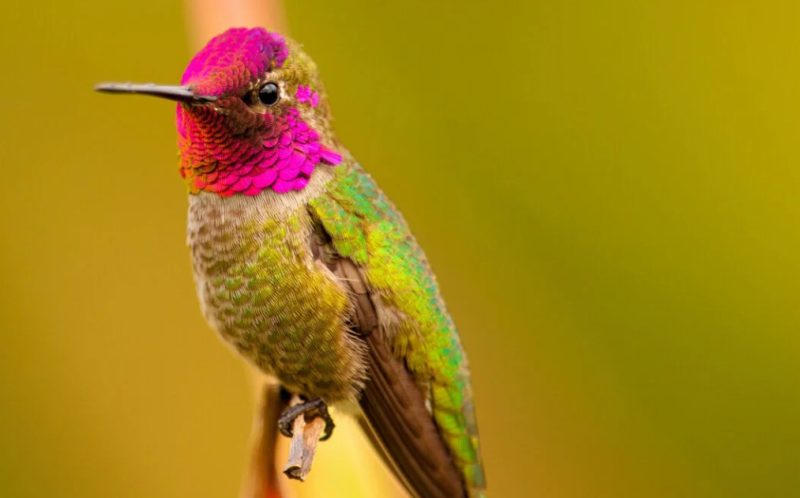
Anna’s Hummingbird is medium-sized, about 3.9 to 4.3 inches in length, with males displaying an iridescent red-pink crown and gorget, while females have green heads and grayish-white underparts. Both sexes have green backs and a slightly forked tail, giving them a distinctive profile. Their strong, straight bills allow feeding from a variety of flowers and feeders.
These hummingbirds are highly adaptable fliers with rapid, precise wingbeats that allow hovering and backward flight. They are bold and often approach humans, particularly where feeders are provided. Courtship displays involve vertical dives with audible wing trills and spreading tail feathers.
Anna’s Hummingbirds feed primarily on nectar and small insects. They can dominate feeding areas, especially in gardens and urban environments. Unlike some migratory hummingbirds, they may remain year-round in areas with sufficient food sources, displaying territorial aggression toward intruders.
In Mississippi, Anna’s Hummingbirds are uncommon, mostly appearing as winter or migratory visitors. They adapt well to urban and suburban habitats with flowering gardens. Their normal range is the western U.S., but they have increasingly been seen in eastern states due to feeder availability.
Broad-billed Hummingbird (Cynanthus latirostris)
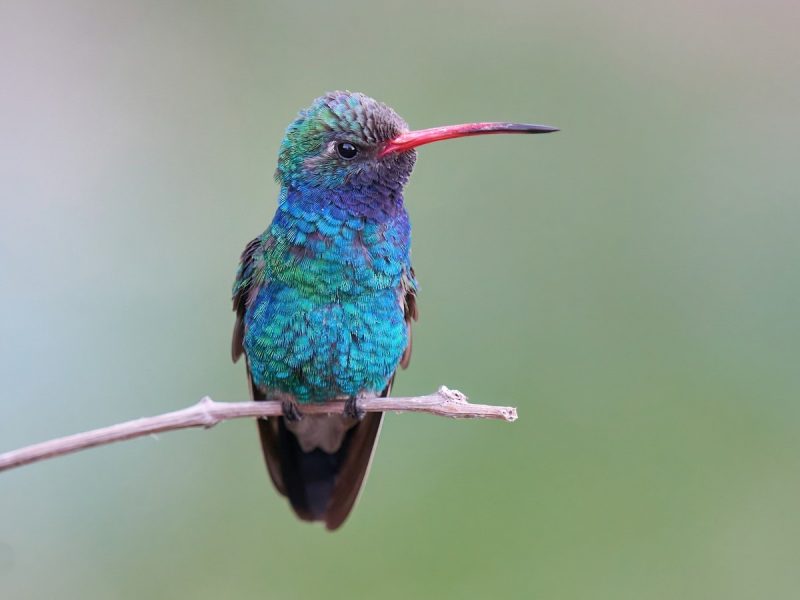
The Broad-billed Hummingbird is recognized by its bright turquoise-blue throat and green back, with males showing a vivid red bill tipped with black. Females have grayish underparts and lack the bright throat, making them more subtle in appearance. Both sexes have slightly rounded tails and a compact body ideal for quick, agile flight.
Adults are about 3.5 inches long with a wingspan of approximately 4 inches. Their flight is fast and precise, with rapid hovering and sudden darting motions between flowers. The iridescent throat of males reflects sunlight, making them highly noticeable in bright conditions.
Broad-billed Hummingbirds feed primarily on nectar from tubular flowers, occasionally capturing insects and spiders. Males are territorial and perform display flights with audible wing sounds to attract females or deter rivals. Courtship includes hovering in front of a female while vibrating the wings to create a buzzing sound.
In Mississippi, Broad-billed Hummingbirds are very rare visitors, mostly found during migration. They prefer gardens, open woodlands, and shrublands when present. Their main range is the southwestern U.S. and Mexico, so sightings in Mississippi are exciting for birdwatchers.
Green-breasted Mango (Anthracothorax prevostii)

The Green-breasted Mango is a striking hummingbird, with metallic green upperparts and a bright orange belly contrasting with a black tail. Males and females are similar, though females may be slightly duller. Their long, slightly curved bills allow feeding from deep tubular flowers. This species is larger than most North American hummingbirds, measuring about 4 inches long.
These hummingbirds are strong fliers, capable of hovering for extended periods while feeding or performing courtship displays. Their bold coloration makes them easy to spot, and they can perform rapid maneuvering to chase competitors or evade predators.
They feed primarily on nectar and small insects. Males are territorial around rich feeding areas but less aggressive than Rufous or Ruby-throated Hummingbirds. Breeding involves elaborate hovering displays and vocalizations to attract mates.
In Mississippi, Green-breasted Mangos are extremely rare vagrants, typically spotted along the southern Gulf Coast. Their main range extends through Central America and parts of Mexico. When present, they inhabit gardens, forest edges, and flowering areas, attracting attention due to their unusual size and vibrant colors.
Mexican Violetear Hummingbird (Colibri thalassinus)

The Mexican Violetear Hummingbird is known for its brilliant violet-colored ear patches and green metallic back. Males have a bright blue-green throat, while females have a more muted throat coloration. Both sexes have long, straight bills adapted to deep tubular flowers. This species is larger than many Selasphorus hummingbirds, measuring about 4.3 inches in length.
These hummingbirds are agile fliers, hovering with rapid wingbeats that allow precise movement among flowers and shrubs. They are capable of hovering midair for long periods while feeding and can execute quick darting flights to avoid threats.
Mexican Violetear Hummingbirds feed on nectar and small insects. Males are territorial during the breeding season, performing aerial displays and wing buzzing to defend feeding territories. They are less common in urban areas compared to more adaptable hummingbird species.
In Mississippi, Mexican Violetears are very rare visitors, generally appearing during migration or as accidental vagrants. They favor gardens, open woodlands, and forest edges with abundant flowering plants. Their natural range extends from Mexico through Central America and parts of northern South America.
Best Time and Places to See Hummingbirds in Mississippi
Mississippi offers prime hummingbird-watching opportunities primarily during spring and fall migration, when many species pass through the state. The peak spring migration occurs from mid-March to late May, while the fall migration happens from August through early October. During these periods, Ruby-throated Hummingbirds are most abundant, while rarer species like Rufous, Broad-billed, and Mexican Violetear may appear sporadically. Winter sightings are generally limited to more adaptable species such as Anna’s Hummingbird and occasional Buff-bellied Hummingbirds along the southern coast.
The best locations include gardens, parks, and woodlands with abundant nectar sources. Residential gardens with flowering plants, hummingbird feeders, and native wildflowers are excellent spots for close observation. Public gardens such as Mississippi Museum of Natural Science Gardens (Jackson) and Natchez Trace Parkway rest areas often attract migrating hummingbirds. Open woodland edges, shrubby fields, and forest clearings provide natural foraging areas for these small birds, especially during early morning and late afternoon when feeding activity peaks.
Coastal areas in southern Mississippi, particularly near Gulfport and Biloxi, are hotspots for rarer tropical and western species like Buff-bellied, Green-breasted Mango, and Mexican Violetear hummingbirds. These locations benefit from subtropical floral resources and mild climates that can support wandering or vagrant hummingbirds during migration.
To maximize sightings, set up multiple feeders with nectar (4 parts water to 1 part sugar, without red dye) and plant tubular flowers such as trumpet creeper, salvia, and bee balm. Observers should stay quiet and patient, as hummingbirds are curious but fast-moving. Early morning is often the most rewarding time, as hummingbirds feed heavily after overnight fasting and before heat or wind reduces activity.
FAQs About Hummingbirds in Mississippi
What hummingbird species are most common in Mississippi?
The most commonly seen species in Mississippi is the Ruby-throated Hummingbird (Archilochus colubris). Other regularly observed species include Rufous Hummingbird, Black-chinned Hummingbird, Buff-bellied Hummingbird, and occasionally Broad-tailed Hummingbird. Rarer vagrants such as Anna’s Hummingbird, Green-breasted Mango, and Mexican Violetear may appear during migration or winter.
When is the best time to see hummingbirds in Mississippi?
Spring (mid-March to late May) and fall (August to early October) migrations are the best times. During these periods, Ruby-throated Hummingbirds are most abundant, while rarer species may appear as vagrants. Winter sightings are limited but possible for species like Anna’s Hummingbird and Buff-bellied Hummingbirds along the Gulf Coast.
Where can I find hummingbirds in Mississippi?
Hummingbirds can be spotted in gardens, parks, woodland edges, and open fields with abundant nectar sources. Southern coastal areas, including Gulfport and Biloxi, attract tropical and western species. Urban gardens with feeders and native flowering plants are especially effective for close-up observation.
What do hummingbirds eat?
Hummingbirds primarily feed on nectar from flowers and sugar water from feeders. They also consume small insects and spiders to meet their protein needs. Popular flowers include trumpet creeper, salvia, bee balm, and cardinal flowers, which provide high-energy nectar.
How can I attract hummingbirds to my garden?
Provide hummingbird feeders filled with nectar (4 parts water to 1 part sugar, no red dye) and plant native flowering plants with tubular blooms. Keep feeders clean and refill them regularly. Creating a mix of shaded and sunny areas and offering perches will encourage hummingbirds to visit and stay longer.
Are hummingbirds territorial in Mississippi?
Yes, males are highly territorial, especially around feeding areas and prime nectar sources. They may chase other hummingbirds, insects, or even larger birds away. Females are less aggressive but will defend small feeding spots when necessary.
Can I see rare hummingbirds like the Broad-billed or Mexican Violetear in Mississippi?
Yes, but sightings are very rare and mostly during migration. These species are typically vagrants from western or tropical ranges and are more often seen along southern coastal areas or in gardens with abundant flowers and feeders.
How long do hummingbirds stay in Mississippi during migration?
Hummingbirds usually stay a few days to a couple of weeks while feeding and resting during migration. Timing depends on weather conditions, availability of nectar sources, and individual bird stamina for long-distance travel.






